Shikun Zhang
SaRO: Enhancing LLM Safety through Reasoning-based Alignment
Apr 13, 2025Abstract:Current safety alignment techniques for large language models (LLMs) face two key challenges: (1) under-generalization, which leaves models vulnerable to novel jailbreak attacks, and (2) over-alignment, which leads to the excessive refusal of benign instructions. Our preliminary investigation reveals semantic overlap between jailbreak/harmful queries and normal prompts in embedding space, suggesting that more effective safety alignment requires a deeper semantic understanding. This motivates us to incorporate safety-policy-driven reasoning into the alignment process. To this end, we propose the Safety-oriented Reasoning Optimization Framework (SaRO), which consists of two stages: (1) Reasoning-style Warmup (RW) that enables LLMs to internalize long-chain reasoning through supervised fine-tuning, and (2) Safety-oriented Reasoning Process Optimization (SRPO) that promotes safety reflection via direct preference optimization (DPO). Extensive experiments demonstrate the superiority of SaRO over traditional alignment methods.
SampleMix: A Sample-wise Pre-training Data Mixing Strategey by Coordinating Data Quality and Diversity
Mar 03, 2025Abstract:Existing pretraining data mixing methods for large language models (LLMs) typically follow a domain-wise methodology, a top-down process that first determines domain weights and then performs uniform data sampling across each domain. However, these approaches neglect significant inter-domain overlaps and commonalities, failing to control the global diversity of the constructed training dataset. Further, uniform sampling within domains ignores fine-grained sample-specific features, potentially leading to suboptimal data distribution. To address these shortcomings, we propose a novel sample-wise data mixture approach based on a bottom-up paradigm. This method performs global cross-domain sampling by systematically evaluating the quality and diversity of each sample, thereby dynamically determining the optimal domain distribution. Comprehensive experiments across multiple downstream tasks and perplexity assessments demonstrate that SampleMix surpasses existing domain-based methods. Meanwhile, SampleMix requires 1.4x to 2.1x training steps to achieves the baselines' performance, highlighting the substantial potential of SampleMix to optimize pre-training data.
Outcome-Refining Process Supervision for Code Generation
Dec 19, 2024



Abstract:Large Language Models have demonstrated remarkable capabilities in code generation, yet they often struggle with complex programming tasks that require deep algorithmic reasoning. While process supervision through learned reward models shows promise in guiding reasoning steps, it requires expensive training data and suffers from unreliable evaluation. We propose Outcome-Refining Process Supervision, a novel paradigm that treats outcome refinement itself as the process to be supervised. Our framework leverages concrete execution signals to ground the supervision of reasoning steps, while using tree-structured exploration to maintain multiple solution trajectories simultaneously. Experiments demonstrate that our approach enables even smaller models to achieve high success accuracy and performance metrics on competitive programming tasks, creates more reliable verification than traditional reward models without requiring training PRMs. Our approach achieves significant improvements across 5 models and 3 datasets: an average of 26.9% increase in correctness and 42.2% in efficiency. The results suggest that providing structured reasoning space with concrete verification signals is crucial for solving complex programming tasks. We open-source all our code and data at: https://github.com/zhuohaoyu/ORPS
SymDPO: Boosting In-Context Learning of Large Multimodal Models with Symbol Demonstration Direct Preference Optimization
Nov 17, 2024Abstract:As language models continue to scale, Large Language Models (LLMs) have exhibited emerging capabilities in In-Context Learning (ICL), enabling them to solve language tasks by prefixing a few in-context demonstrations (ICDs) as context. Inspired by these advancements, researchers have extended these techniques to develop Large Multimodal Models (LMMs) with ICL capabilities. However, existing LMMs face a critical issue: they often fail to effectively leverage the visual context in multimodal demonstrations and instead simply follow textual patterns. This indicates that LMMs do not achieve effective alignment between multimodal demonstrations and model outputs. To address this problem, we propose Symbol Demonstration Direct Preference Optimization (SymDPO). Specifically, SymDPO aims to break the traditional paradigm of constructing multimodal demonstrations by using random symbols to replace text answers within instances. This forces the model to carefully understand the demonstration images and establish a relationship between the images and the symbols to answer questions correctly. We validate the effectiveness of this method on multiple benchmarks, demonstrating that with SymDPO, LMMs can more effectively understand the multimodal context within examples and utilize this knowledge to answer questions better.
SG-Bench: Evaluating LLM Safety Generalization Across Diverse Tasks and Prompt Types
Oct 29, 2024Abstract:Ensuring the safety of large language model (LLM) applications is essential for developing trustworthy artificial intelligence. Current LLM safety benchmarks have two limitations. First, they focus solely on either discriminative or generative evaluation paradigms while ignoring their interconnection. Second, they rely on standardized inputs, overlooking the effects of widespread prompting techniques, such as system prompts, few-shot demonstrations, and chain-of-thought prompting. To overcome these issues, we developed SG-Bench, a novel benchmark to assess the generalization of LLM safety across various tasks and prompt types. This benchmark integrates both generative and discriminative evaluation tasks and includes extended data to examine the impact of prompt engineering and jailbreak on LLM safety. Our assessment of 3 advanced proprietary LLMs and 10 open-source LLMs with the benchmark reveals that most LLMs perform worse on discriminative tasks than generative ones, and are highly susceptible to prompts, indicating poor generalization in safety alignment. We also explain these findings quantitatively and qualitatively to provide insights for future research.
MaVEn: An Effective Multi-granularity Hybrid Visual Encoding Framework for Multimodal Large Language Model
Aug 26, 2024Abstract:This paper presents MaVEn, an innovative Multi-granularity Visual Encoding framework designed to enhance the capabilities of Multimodal Large Language Models (MLLMs) in multi-image reasoning. Current MLLMs primarily focus on single-image visual understanding, limiting their ability to interpret and integrate information across multiple images. MaVEn addresses this limitation by combining discrete visual symbol sequences, which abstract coarse-grained semantic concepts, with traditional continuous representation sequences that model fine-grained features. This dual approach bridges the semantic gap between visual and textual data, thereby improving the model's ability to process and interpret information from multiple images effectively. Additionally, we design a dynamic reduction mechanism by for long-sequence continuous features to enhance multi-image processing efficiency. Experimental results demonstrate that MaVEn significantly enhances MLLMs' understanding in complex multi-image scenarios, while also improving performance in single-image contexts.
Recent Advances on Machine Learning for Computational Fluid Dynamics: A Survey
Aug 22, 2024Abstract:This paper explores the recent advancements in enhancing Computational Fluid Dynamics (CFD) tasks through Machine Learning (ML) techniques. We begin by introducing fundamental concepts, traditional methods, and benchmark datasets, then examine the various roles ML plays in improving CFD. The literature systematically reviews papers in recent five years and introduces a novel classification for forward modeling: Data-driven Surrogates, Physics-Informed Surrogates, and ML-assisted Numerical Solutions. Furthermore, we also review the latest ML methods in inverse design and control, offering a novel classification and providing an in-depth discussion. Then we highlight real-world applications of ML for CFD in critical scientific and engineering disciplines, including aerodynamics, combustion, atmosphere & ocean science, biology fluid, plasma, symbolic regression, and reduced order modeling. Besides, we identify key challenges and advocate for future research directions to address these challenges, such as multi-scale representation, physical knowledge encoding, scientific foundation model and automatic scientific discovery. This review serves as a guide for the rapidly expanding ML for CFD community, aiming to inspire insights for future advancements. We draw the conclusion that ML is poised to significantly transform CFD research by enhancing simulation accuracy, reducing computational time, and enabling more complex analyses of fluid dynamics. The paper resources can be viewed at https://github.com/WillDreamer/Awesome-AI4CFD.
RAGLAB: A Modular and Research-Oriented Unified Framework for Retrieval-Augmented Generation
Aug 21, 2024
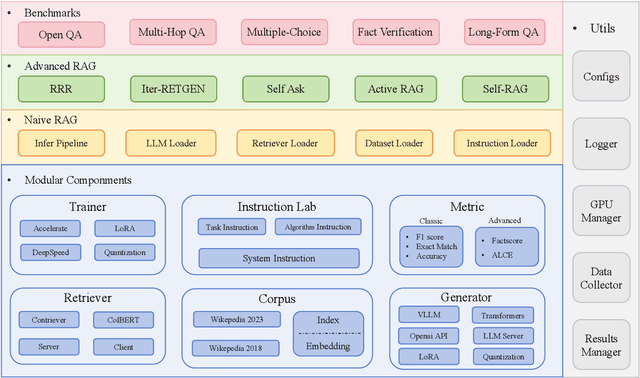

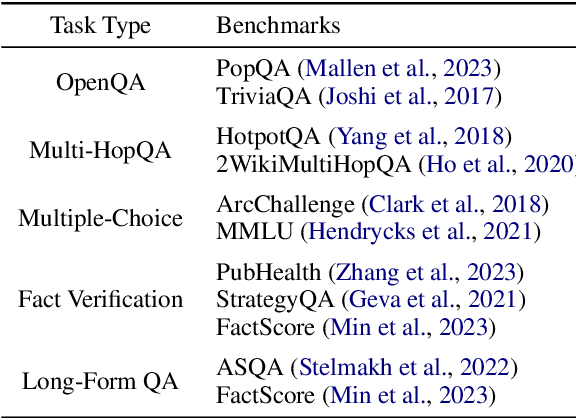
Abstract:Large Language Models (LLMs) demonstrate human-level capabilities in dialogue, reasoning, and knowledge retention. However, even the most advanced LLMs face challenges such as hallucinations and real-time updating of their knowledge. Current research addresses this bottleneck by equipping LLMs with external knowledge, a technique known as Retrieval Augmented Generation (RAG). However, two key issues constrained the development of RAG. First, there is a growing lack of comprehensive and fair comparisons between novel RAG algorithms. Second, open-source tools such as LlamaIndex and LangChain employ high-level abstractions, which results in a lack of transparency and limits the ability to develop novel algorithms and evaluation metrics. To close this gap, we introduce RAGLAB, a modular and research-oriented open-source library. RAGLAB reproduces 6 existing algorithms and provides a comprehensive ecosystem for investigating RAG algorithms. Leveraging RAGLAB, we conduct a fair comparison of 6 RAG algorithms across 10 benchmarks. With RAGLAB, researchers can efficiently compare the performance of various algorithms and develop novel algorithms.
Refining Corpora from a Model Calibration Perspective for Chinese Spelling Correction
Jul 22, 2024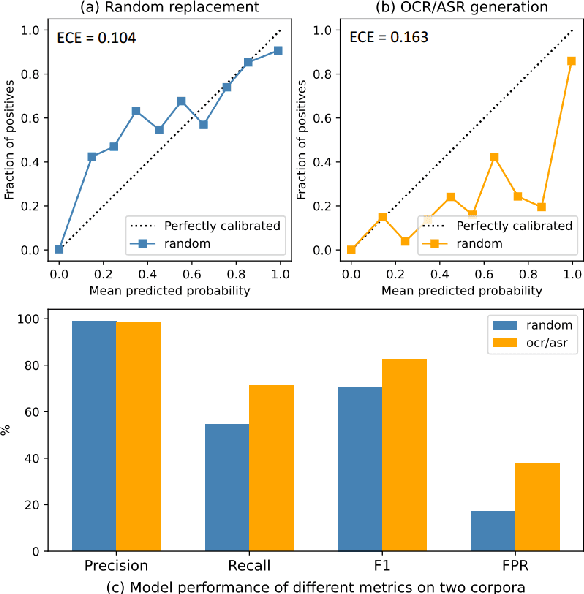

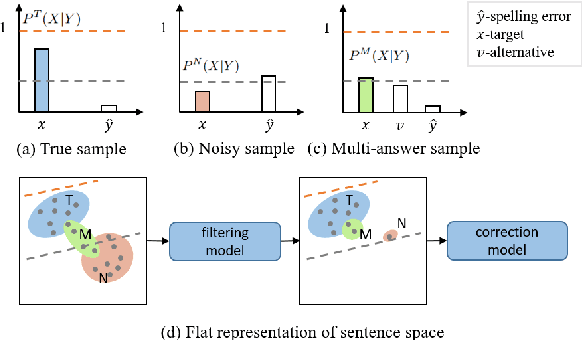
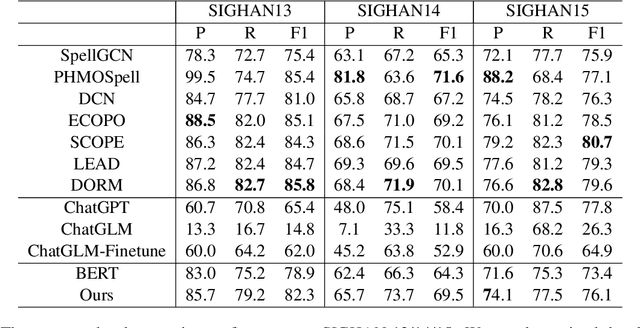
Abstract:Chinese Spelling Correction (CSC) commonly lacks large-scale high-quality corpora, due to the labor-intensive labeling of spelling errors in real-life human writing or typing scenarios. Two data augmentation methods are widely adopted: (1) \textit{Random Replacement} with the guidance of confusion sets and (2) \textit{OCR/ASR-based Generation} that simulates character misusing. However, both methods inevitably introduce noisy data (e.g., false spelling errors), potentially leading to over-correction. By carefully analyzing the two types of corpora, we find that though the latter achieves more robust generalization performance, the former yields better-calibrated CSC models. We then provide a theoretical analysis of this empirical observation, based on which a corpus refining strategy is proposed. Specifically, OCR/ASR-based data samples are fed into a well-calibrated CSC model trained on random replacement-based corpora and then filtered based on prediction confidence. By learning a simple BERT-based model on the refined OCR/ASR-based corpus, we set up impressive state-of-the-art performance on three widely-used benchmarks, while significantly alleviating over-correction (e.g., lowering false positive predictions).
Enhancing In-Context Learning via Implicit Demonstration Augmentation
Jun 27, 2024



Abstract:The emergence of in-context learning (ICL) enables large pre-trained language models (PLMs) to make predictions for unseen inputs without updating parameters. Despite its potential, ICL's effectiveness heavily relies on the quality, quantity, and permutation of demonstrations, commonly leading to suboptimal and unstable performance. In this paper, we tackle this challenge for the first time from the perspective of demonstration augmentation. Specifically, we start with enriching representations of demonstrations by leveraging their deep feature distribution. We then theoretically reveal that when the number of augmented copies approaches infinity, the augmentation is approximately equal to a novel logit calibration mechanism integrated with specific statistical properties. This insight results in a simple yet highly efficient method that significantly improves the average and worst-case accuracy across diverse PLMs and tasks. Moreover, our method effectively reduces performance variance among varying demonstrations, permutations, and templates, and displays the capability to address imbalanced class distributions.
 Add to Chrome
Add to Chrome Add to Firefox
Add to Firefox Add to Edge
Add to Edge